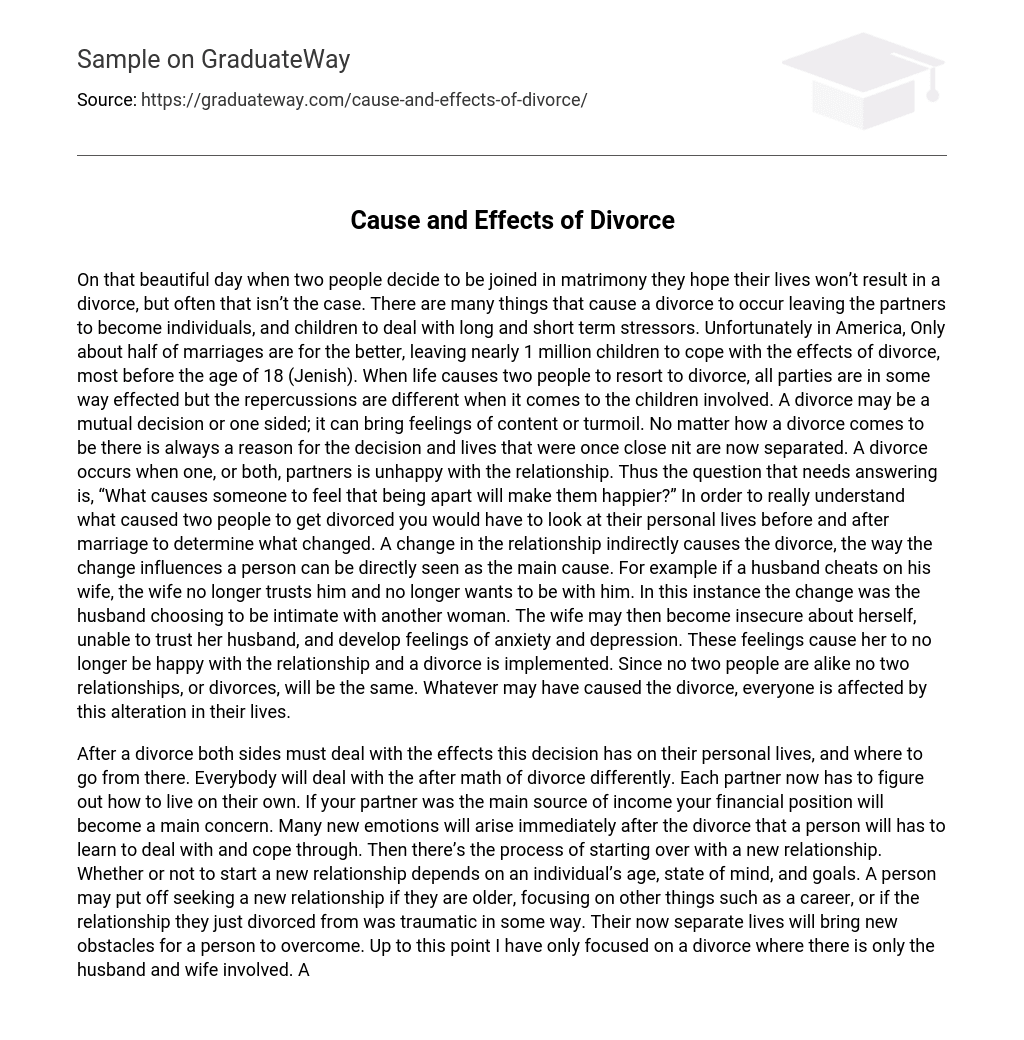When two individuals choose to enter into the sacred bond of marriage, they do so with the hopeful expectation of a lifelong commitment. Unfortunately, marriages oftentimes end in divorce due to various reasons, causing immense stress and turmoil for both partners involved as well as their children. Shockingly, almost 1 million children under the age of 18 in America are directly impacted by the approximately 50% of marriages that ultimately result in divorce (Jenish). The effects of divorce can vary greatly for each individual affected, whether it be a mutual decision or one-sided, leading to either contentment or chaos.
Regardless of the circumstances surrounding a divorce, there is always an underlying reason behind this life-altering decision that ultimately results in previously closely-knit lives unraveling and becoming separate entities. This decision typically arises when one or both partners find themselves unhappy within the confines of their relationship. This begs us to ponder: what drives someone to believe that happiness lies outside of their current union? In order to truly comprehend why couples choose to dissolve their marriage vows, it becomes imperative to carefully analyze their personal lives both before and after entering into matrimony. By doing so, we are able to identify any changes that may have occurred within these relationships which indirectly lead to divorce while simultaneously becoming its primary catalyst.
Within this text’s exploration on the consequences of infidelity within a marriage setting, it becomes apparent that when a husband engages in unfaithful behavior, his wife inevitably loses trust and her desire to remain committed dwindles significantly. Such shifts within the dynamics of this spousal relationship can result in a plethora of negative emotions including insecurity, distrustfulness as well as feelings encompassing anxiety and depression for the wife involved.Therefore, she may decide to terminate the relationship by getting a divorce. The text emphasizes that every relationship and divorce experience is different, but it also emphasizes that everyone involved is affected by this major life change.
After a divorce, both parties must face the consequences it has on their personal lives and determine their next steps. Each individual will handle the aftermath of divorce in their own way. It is crucial for each partner to now figure out how to live independently. If one partner was the primary source of income, their financial situation becomes a major concern. Right after the divorce, a person will experience various new emotions that they need to learn to manage and overcome. Moreover, they might decide to initiate a new relationship based on factors like age, state of mind, and personal goals. Depending on their circumstances, older individuals or those who had an especially traumatic previous marriage may choose to postpone pursuing a new relationship.
Separate lives come with fresh challenges that individuals need to conquer. So far, I have only discussed divorces involving just the husband and wife. However, when children are involved, there are entirely different impacts on the process. The custody of children becomes a significant factor in parents’ divorce proceedings.The court plays a crucial role in deciding custody arrangements for parents going through a divorce, including how custody will be shared. This means that the divorcing parent must adjust to new ways of caring for their children. In order to determine the most suitable caregiver for a young child, the court thoroughly examines both parents’ lives. If one parent is granted full custody, they have the authority to decide how involved the other parent can be in their child’s life. In cases of joint custody, both parents must work together to establish how parenting responsibilities will be divided. Depending on state regulations, children aged 12-15 may have the ability to choose which parent they want to live with. This stage often brings about intense emotions as no loving parent wants their children to be separated from them.
According to a 1994 study by Arizona State University, the primary impact of divorce is on the children involved. The study suggests that it is not the divorce itself, but rather the stressors that follow, which affect the child’s well-being. Over time, children may employ different strategies to cope with stress and may switch between strategies. Short-term stress is often managed through avoidance and distraction, while long-term issues require active and supportive methods. These methods have been proven effective in addressing long-term effects (Sandler, Tein, & West).
Regardless of their age at the time of divorce, children’s lives are significantly disrupted as a result. It is estimated that 20-50% of these children will endure lasting trauma. Psychologist Judith Wallerstein conducted a 15-year study examining 130 children from divorced families and found that boys tend to immediately respond outwardly to grief while girls tend to become more introverted and display symptoms over an extended period (Gleick).
Both boys and girls from divorced families face an increased risk of substance abuse, depression, and intimacy problems. The eldest child in a family affected by divorce typically bears more responsibility and endures higher levels of stress compared to their younger siblings. They are compelled to take on added duties that they would not have otherwise had (Sandler et al., Gleick).Sandler, Tein, and West suggest that younger children might face difficulties when trying to adjust to the new demands and stresses placed on them.
Divorce is unfortunately common and almost expected in our society. It is a complex issue with no specific cause. However, changes in a marriage lead people to no longer want to be together. Divorce affects the lives of the married couple in various ways as they transition from being partners to individuals. Additionally, it significantly alters the future of children, who have to deal with numerous stressors. Despite its negative effects, programs aimed at helping adults and children cope with these challenges have been created due to the frequency of divorce. Hopefully, our society will eventually remember the true meaning of marriage and the severity of its effects on those involved.





